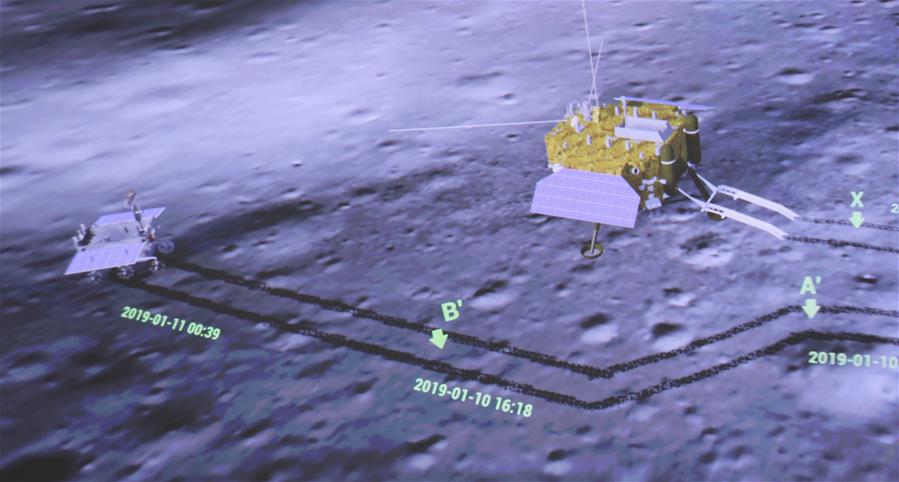


Photo taken by the rover Yutu-2 (Jade Rabbit-2) on Jan 11, 2019 shows the lander of the Chang'e-4 probe. With the assistance of the relay satellite Queqiao (Magpie Bridge), the rover Yutu-2 (Jade Rabbit-2) and the lander of the Chang'e-4 probe took photos of each other. [Photo/Xinhua/China National Space Administration]
China announced on Friday that the Chang'e 4 mission, which conducted mankind's first surface observation of the moon's far side, "a complete success".
The China National Space Administration said in a statement that the two components of the Chang'e 4 robotic probe — the lander and the Yutu 2, or Jade Rabbit 2, rover — took pictures of each other that were transmitted to ground control via the Queqiao relay satellite.
All scientific equipment mounted on the lander and rover has functioned well and their data have been received by ground control. Scientific experiments are underway without any problem, the administration said, explaining that all were successful.
Also on Friday, cameras mounted on the lander took panoramic images of the landing site, enabling researchers to do a topographical analysis, it said.
The Central Committee of the Communist Party of China, the State Council and Central Military Commission jointly sent a congratulatory letter to the Chang'e 4 mission team.

The screen at the Beijing Aerospace Control Center shows the Chang'e-4 lander (R) and the Yutu-2 rover taking pictures for each other, Jan 11, 2019. [Photo/Xinhua]
It called the mission a new landmark in China's space industry of self-reliance and innovation, a symbol that China is on the path of becoming a strong space power and a major contribution to space exploration.
With Chang'e 4's success, a new chapter in China's lunar and deep-space exploration programs is about to commence, and the tasks and challenges ahead will be unprecedented, the letter said.
Chang'e 4 was launched atop a Long March 3B rocket in early December at the Xichang Satellite Launch Center in Sichuan province. It is the country's fourth lunar exploration and the world's first expedition to successfully land on the moon's far side, most of which never faces Earth.
The robotic probe made a soft landing on the far side on Jan 3 and then released Yutu 2, the seventh rover on the moon and the first to get to the far side, to roam and survey the landing site in the South Pole-Aitken Basin, one of the largest known impact craters in the solar system.
Yutu 2 was activated on Thursday after a short standby mode that started around Jan 5 to protect its devices from possible damage caused by direct solar radiation. Yutu 2, weighing 140 kilograms, is the lightest rover of its kind.

Photo taken by the lander of the Chang'e-4 probe on Jan 11, 2019 shows the rover Yutu-2 (Jade Rabbit-2). [Photo/Xinhua/China National Space Administration]
China launched its lunar exploration program in 2004, naming it Chang'e after the goddess of the moon in Chinese legend.
The first Chinese lunar explorer, the Chang'e 1 orbiter, was launched in October 2007.
The Chang'e 2 orbiter was launched in October 2010 to conduct high-definition imaging of the moon and verify the suitability of the Chang'e 3 landing site.
The Chang'e 3 probe was launched in December 2013 and was the first Chinese spacecraft to touch down on the lunar surface. The mission marked the first soft landing by a man-made object on the moon in nearly four decades. Carried by Chang'e 3, Yutu, the first Chinese lunar rover, worked on the moon for nearly 1,000 days. Chang'e 3's lander is still operational and sending back data to Earth.
The next step in China's lunar exploration, the Chang'e 5 mission, is set to take place before the end of this year. Its rover is designed to collect samples and bring them back to Earth.

 Award-winning photos show poverty reduction achievements in NE China's Jilin province
Award-winning photos show poverty reduction achievements in NE China's Jilin province People dance to greet advent of New Year in Ameiqituo Town, Guizhou
People dance to greet advent of New Year in Ameiqituo Town, Guizhou Fire brigade in Shanghai holds group wedding
Fire brigade in Shanghai holds group wedding Tourists enjoy ice sculptures in Datan Town, north China
Tourists enjoy ice sculptures in Datan Town, north China Sunset scenery of Dayan Pagoda in Xi'an
Sunset scenery of Dayan Pagoda in Xi'an Tourists have fun at scenic spot in Nanlong Town, NW China
Tourists have fun at scenic spot in Nanlong Town, NW China Harbin attracts tourists by making best use of ice in winter
Harbin attracts tourists by making best use of ice in winter In pics: FIS Alpine Ski Women's World Cup Slalom
In pics: FIS Alpine Ski Women's World Cup Slalom Black-necked cranes rest at reservoir in Lhunzhub County, Lhasa
Black-necked cranes rest at reservoir in Lhunzhub County, Lhasa China's FAST telescope will be available to foreign scientists in April
China's FAST telescope will be available to foreign scientists in April